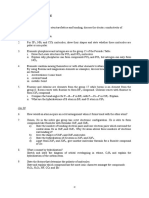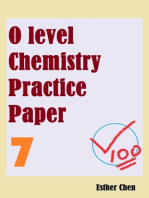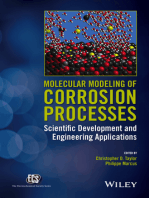Chapter Two Bonding and Structure
Chapter Two Bonding and Structure
Uploaded by
shucayb mohamedCopyright:
Available Formats
Chapter Two Bonding and Structure
Chapter Two Bonding and Structure
Uploaded by
shucayb mohamedOriginal Description:
Original Title
Copyright
Available Formats
Share this document
Did you find this document useful?
Is this content inappropriate?
Copyright:
Available Formats
Chapter Two Bonding and Structure
Chapter Two Bonding and Structure
Uploaded by
shucayb mohamedCopyright:
Available Formats
Chapter two bonding and structure
Name: ------------------------- class -------------- NO ---------------
1. What are the three types of bonding
A. Ionic bond –which occurs between metals and non-metals
B. Covalent bonding –which occurs between two non-metals
C. Metallic bond -metal cations and delocalized electrons.
2. Draw dot and cross for the following ionic compounds
A. KF this is ionic compounds of potassium fluoride
You draw only the last shell, K has 19 proton number so it has the
following electron configuration of 2,8,8,1 so it loses two one electron to
become full outer shell electron. And fluorine has 9 proton number so it
has the following electron configuration 2,7 so it needs to gain one
electron to become full outer shell electron
B. Draw dot and cross of Na2O
C. Mg O --------------------------------------------------------------------------------
D. Cacl2---------------------------------------------------------------------------------
E. Li3N -------------------------------------------------------------------------------
F. Alcl3 --------------------------------------------------------------------------
3. What is the formulae of
A. Magnesium hydroxide ------------------------------------------------------------
B. Sodium sulfate --------------------------------------------------------------------
1|Abdirisaq Mohamed ALi
C. Ammonium sulfate ---------------------------------------------------------------
D. Calcium nitrate -----------------------------------------------------------------
Some common ionic compounds with their valence
Valence of the periodic table
2|Abdirisaq Mohamed ALi
4. List the properties of ionic compounds
- They are crystalline solids, and are brittle in nature.
- They have high melting and boiling points.
- They are soluble in water.
- They conduct electricity in their solution and molten states.
5. List the types of covalent bonding
A. Single bonding - Single bond symbol: A single line represents a bond
between two atoms (i.e., involving one electron pair) Single bond example:
Cl2, HCl, NH3
B. Double bonding - Two atoms share two pairs of electrons to complete their
octet. Oxygen gas, carbon dioxide, acetone, and ozone.
C. Triple bonding - a covalent linkage in which two atoms share three pairs of
electrons, as in the nitrogen molecule, N2, or acetylene, C2H2.
This is an example of single, double and triple bound
6. What are the limitation of the octet rule
A. The incomplete octet of the central atom-less than 8 electrons in the
central atom after bond forming between the central atom and the
surrounding atom, examples are BF3, BCL3 and BH3
B. The expanded atom - occurs when an atom is able to have more than 8
valence electrons. Examples SF6 , PCl5
7. list the properties of covalent bond
- The boiling/melting points of covalent compounds are low.
- They are soft in nature and relatively flexible.
3|Abdirisaq Mohamed ALi
- These compounds do not possess electrical conductivity.
- They have lower values of enthalpy of fusion/vaporization
8. Draw dot and cross diagrams of carbon dioxide, nitrogen molecule and oxygen
molecule
A. Which of the three molecules has one double bond answer CO2
B. Which of the three molecules has two double bonds answer O2
C. Which of the three has one triple bond answer N3
9. What is meant by lone-pair?
- Is a pair of valence electrons that are not shared with another atom in a
covalent bond
- NH3 has only one lone pair
- Draw the lone pair of water molecule H2O
- Draw CH3 and show the lone pair
10.Define coordinate(dative) covalent bond
- A coordinate bond (also called a dative covalent bond) is a covalent bond
(a shared pair of electrons) in which both electrons come from the same
atom
Examples
4|Abdirisaq Mohamed ALi
- The Reaction between Ammonia and Hydrogen Chloride. NH3 +HCL-
- Reaction between ammonia and boron trifluoride. NH3 +HF -
- The structure of Aluminum Chloride.
.
11.BF3 and gaseous ammonia (NH3) combine to form a white solid with formulae
F3BNH 3. There is a bond between boron and nitrogen. Draw dot and cross
diagram and displayed formulae of F3BNH3.
12. A water molecule can form a dative to an H+, forming oxonion or hydronium
ion. Draw a dot and cross diagram and the displayed formulae for the oxonium
ion?
13.Draw cross and dot diagram for Ozone O3?
5|Abdirisaq Mohamed ALi
You might also like
- Chemistry Final Worksheet Grade 9Document9 pagesChemistry Final Worksheet Grade 9Lama AshiNo ratings yet
- TT2.1 - Ionic and Covalent BondDocument9 pagesTT2.1 - Ionic and Covalent BondDaniel VictoriaNo ratings yet
- I PUC Model QP AnswerDocument8 pagesI PUC Model QP AnswerSamanth PattarNo ratings yet
- Sem 1 Chapter 3 Covalent Bond Pt2Document9 pagesSem 1 Chapter 3 Covalent Bond Pt2Kishaar BaluNo ratings yet
- Review Homework Chap-3Document5 pagesReview Homework Chap-3WhitneyNo ratings yet
- 11 Chemistry PP Ch4 Chemical Bonding Molecular StructureDocument6 pages11 Chemistry PP Ch4 Chemical Bonding Molecular StructureJwalant100% (1)
- Homework Booklet (4, D)Document49 pagesHomework Booklet (4, D)Anupa Medhekar100% (1)
- Team Members: List of Members Who Prepared Question Bank For Chemistry For Class XiiDocument134 pagesTeam Members: List of Members Who Prepared Question Bank For Chemistry For Class XiiShivam AroraNo ratings yet
- Higher Thinking QuestionsDocument4 pagesHigher Thinking QuestionsCaron AsgaraliNo ratings yet
- 11 Chemistry Impq Ch04 Chemical Bonding and Molecular Structure KvsDocument6 pages11 Chemistry Impq Ch04 Chemical Bonding and Molecular Structure KvsPratapSinghMuniaNo ratings yet
- CompleteDocument17 pagesCompleteTelNo ratings yet
- CarbonylDocument37 pagesCarbonylmariamtariq659No ratings yet
- Practice Worksheet On Bonding PDFDocument4 pagesPractice Worksheet On Bonding PDFOliver SetyomulyonoNo ratings yet
- Bonding and Lewis Structures WorksheetDocument2 pagesBonding and Lewis Structures WorksheetLarry MolinerosNo ratings yet
- Carbonyles 1Document38 pagesCarbonyles 1mariamtariq659No ratings yet
- Atoms Molecules and IonsDocument46 pagesAtoms Molecules and Ionschandro57No ratings yet
- Year 9-Chemistry Summer Break HomeworkDocument8 pagesYear 9-Chemistry Summer Break HomeworkmuzamilisthebestatmathNo ratings yet
- Practise 2022Document3 pagesPractise 2022osebe.bisonga23No ratings yet
- Lewis Structure PracticeDocument4 pagesLewis Structure PracticeNoelani-Mei AscioNo ratings yet
- Introduction To Chemistry 4Th Edition Bauer Test Bank Full Chapter PDFDocument67 pagesIntroduction To Chemistry 4Th Edition Bauer Test Bank Full Chapter PDFblanchetranw6er8d100% (16)
- Periodic Table SQDocument17 pagesPeriodic Table SQNg Swee Loong StevenNo ratings yet
- Review - Before Final 2023 - AnswersDocument9 pagesReview - Before Final 2023 - Answerstranglq.23bi14429No ratings yet
- Chapter05. Ionic BondDocument5 pagesChapter05. Ionic BondKelso ZwariyaNo ratings yet
- Focus 3 Chemical BondingDocument10 pagesFocus 3 Chemical BondingHengLow100% (1)
- Homework Booklet (4, D)Document48 pagesHomework Booklet (4, D)LionelNo ratings yet
- Chemistry Pahang JUJ 2008 (Edu - Joshuatly.com)Document55 pagesChemistry Pahang JUJ 2008 (Edu - Joshuatly.com)Apple KWNo ratings yet
- Revision Worksheet Unit 1 - 3: Chem 1Document6 pagesRevision Worksheet Unit 1 - 3: Chem 1abashir7852No ratings yet
- Topic 3Document22 pagesTopic 3ChaudhryAbdullahNo ratings yet
- TextoDocument13 pagesTextoFRANSNo ratings yet
- Grade 10 - Chemical BondsDocument13 pagesGrade 10 - Chemical Bondsaaronfdo.1105No ratings yet
- XIICOORDINATIONModule 1Document7 pagesXIICOORDINATIONModule 1Arpit KumarNo ratings yet
- Ncert Solutions March9 For Class 11 Chemistry Chapter 4Document32 pagesNcert Solutions March9 For Class 11 Chemistry Chapter 4Sarojini MallickNo ratings yet
- 86 95Document167 pages86 95Ashwin KirtaneNo ratings yet
- Lawrance Text ProblemsDocument23 pagesLawrance Text ProblemsvnNo ratings yet
- ch4 13Document26 pagesch4 13Jamunadevi RajkumarNo ratings yet
- G10-2nd-Q-review Sheets-Chem-Chap7, 8.1, 8.2Document8 pagesG10-2nd-Q-review Sheets-Chem-Chap7, 8.1, 8.2Karim Ahmed100% (1)
- Homework 4Document7 pagesHomework 4JairoJacobNo ratings yet
- Revision Booklet (5, S)Document33 pagesRevision Booklet (5, S)ashokNo ratings yet
- Ali and AdilDocument2 pagesAli and Adilسمير العطارNo ratings yet
- Covalent Bondingwork SheetDocument3 pagesCovalent Bondingwork SheetMikas TesfuNo ratings yet
- NCERT Solutions For Class 11 Chemistry Chapter 4 - Chemical Bonding and Molecular Structure - .Document25 pagesNCERT Solutions For Class 11 Chemistry Chapter 4 - Chemical Bonding and Molecular Structure - .h85195709No ratings yet
- Q1/ DR AdilDocument2 pagesQ1/ DR Adilسمير العطارNo ratings yet
- Chapter 4 Chemical Bonding and Molecular StructureDocument26 pagesChapter 4 Chemical Bonding and Molecular StructureYash PlayNo ratings yet
- Q1/ DR AdilDocument2 pagesQ1/ DR Adilسمير العطارNo ratings yet
- Sem1 Unit4 Chemical BondingDocument11 pagesSem1 Unit4 Chemical BondingRajNo ratings yet
- Chemical Bonding Assignment 2 AnswersDocument5 pagesChemical Bonding Assignment 2 AnswersdarylchenNo ratings yet
- Practice Test Chapter 8 ReimerDocument9 pagesPractice Test Chapter 8 ReimerSoundharya VairavanNo ratings yet
- SPM Chemistry Revision Module On The BasicsDocument64 pagesSPM Chemistry Revision Module On The Basicssuritanu96No ratings yet
- Chapter 7 - Ionic and Metallic Bonding: AugustineDocument52 pagesChapter 7 - Ionic and Metallic Bonding: AugustineZhansarin Miras 7aNo ratings yet
- Endohedral Metallofullerenes: Fullerenes with Metal InsideFrom EverandEndohedral Metallofullerenes: Fullerenes with Metal InsideNo ratings yet
- Amorphous Semiconductors: Structural, Optical, and Electronic PropertiesFrom EverandAmorphous Semiconductors: Structural, Optical, and Electronic PropertiesNo ratings yet
- Simulation of Transport in NanodevicesFrom EverandSimulation of Transport in NanodevicesFrançois TriozonNo ratings yet
- Sustainable and Green Electrochemical Science and TechnologyFrom EverandSustainable and Green Electrochemical Science and TechnologyNo ratings yet
- Molecular Modeling of Corrosion Processes: Scientific Development and Engineering ApplicationsFrom EverandMolecular Modeling of Corrosion Processes: Scientific Development and Engineering ApplicationsNo ratings yet
- Practice Makes Perfect in Chemistry: Compounds, Reactions and MolesFrom EverandPractice Makes Perfect in Chemistry: Compounds, Reactions and MolesNo ratings yet
- Chapter 10 The S-Block ElementsDocument11 pagesChapter 10 The S-Block ElementsNitish MehraNo ratings yet
- Reading Material 2 Basic ChemistryDocument15 pagesReading Material 2 Basic ChemistryCj IsoNo ratings yet
- Solutions Practice Test: Multiple ChoiceDocument7 pagesSolutions Practice Test: Multiple Choicesana iqbalNo ratings yet
- Hobart Self-Shield Wire PresenDocument30 pagesHobart Self-Shield Wire Presenalefeli26No ratings yet
- KCET 2020 Chemistry Question Answerkey SolutionsDocument22 pagesKCET 2020 Chemistry Question Answerkey Solutionsaswath ventraNo ratings yet
- Melanie V. Antolin Bs Met 1-1 Chem 2208 LecDocument6 pagesMelanie V. Antolin Bs Met 1-1 Chem 2208 LecMELANIE ANTOLINNo ratings yet
- Teaching Notes Chapter 3 Asal ChemistryDocument31 pagesTeaching Notes Chapter 3 Asal ChemistryJoko SusiloNo ratings yet
- Nomenclature Equations, and Reactions Review Page 164Document4 pagesNomenclature Equations, and Reactions Review Page 164DanielNo ratings yet
- Practicals-Class Xi Salt AnalysisDocument12 pagesPracticals-Class Xi Salt AnalysisMariappan NatarajanNo ratings yet
- Ionic Bonding - Pauling's Rules and The Bond Valence MethodDocument10 pagesIonic Bonding - Pauling's Rules and The Bond Valence MethodSandra AhmadNo ratings yet
- Class1 Homework Chapter 3Document11 pagesClass1 Homework Chapter 3Ela BallıoğluNo ratings yet
- Jaron Bijaron FinalDocument12 pagesJaron Bijaron FinalshowmikNo ratings yet
- Chemistry Classification of Elements and Periodicity in PropertiesDocument20 pagesChemistry Classification of Elements and Periodicity in PropertiesRahul RameshNo ratings yet
- 01 ChemicalBondingDocument93 pages01 ChemicalBondingRIP- PIRNo ratings yet
- Activity No. 1 Difference Between Organic and Inorganic Compounds ObjectiveDocument3 pagesActivity No. 1 Difference Between Organic and Inorganic Compounds ObjectiveZyra Erylle Rodriguez CapistranoNo ratings yet
- Basic Principle of Extraction of IronDocument35 pagesBasic Principle of Extraction of IronHimanshuNo ratings yet
- MCQ New 2023 Metals & Non MetalsDocument3 pagesMCQ New 2023 Metals & Non MetalsMY WORLDNo ratings yet
- CAR No 01Document2 pagesCAR No 01Ra'oufAli-zadehNo ratings yet
- Electrochem 1Document77 pagesElectrochem 1SATYENDRANo ratings yet
- Articulo - Sintesis de Tribencil EstañoDocument9 pagesArticulo - Sintesis de Tribencil EstañoFreider CaicedoNo ratings yet
- BMS1011 W1L1Document39 pagesBMS1011 W1L1PutterNo ratings yet
- IdoformsDocument27 pagesIdoformsRudransh GuptaNo ratings yet
- DPP - 02 - Chemical Bonding (Hybridization)Document21 pagesDPP - 02 - Chemical Bonding (Hybridization)amritanshushekhar48No ratings yet
- Coordination Chemistry of Salicylic AcidDocument3 pagesCoordination Chemistry of Salicylic AcidinventionjournalsNo ratings yet
- Week 2a - Eight Forms of CorrosionDocument35 pagesWeek 2a - Eight Forms of CorrosionAraasu EgambaramNo ratings yet
- Units ConversDocument8 pagesUnits ConversAbderrahmane AbderrahmaniNo ratings yet
- IE Atomic Transf IIIDocument2 pagesIE Atomic Transf IIIPeter GrandicsNo ratings yet
- Kandungan PakanDocument9 pagesKandungan Pakannabas NabasNo ratings yet
- CBSE Class 9 Science Chapter 3 Atoms and Molecules Revision NotesDocument45 pagesCBSE Class 9 Science Chapter 3 Atoms and Molecules Revision NotesOm KumarNo ratings yet
- Chapter 5 Lec 4Document3 pagesChapter 5 Lec 4IsaNo ratings yet

























































































